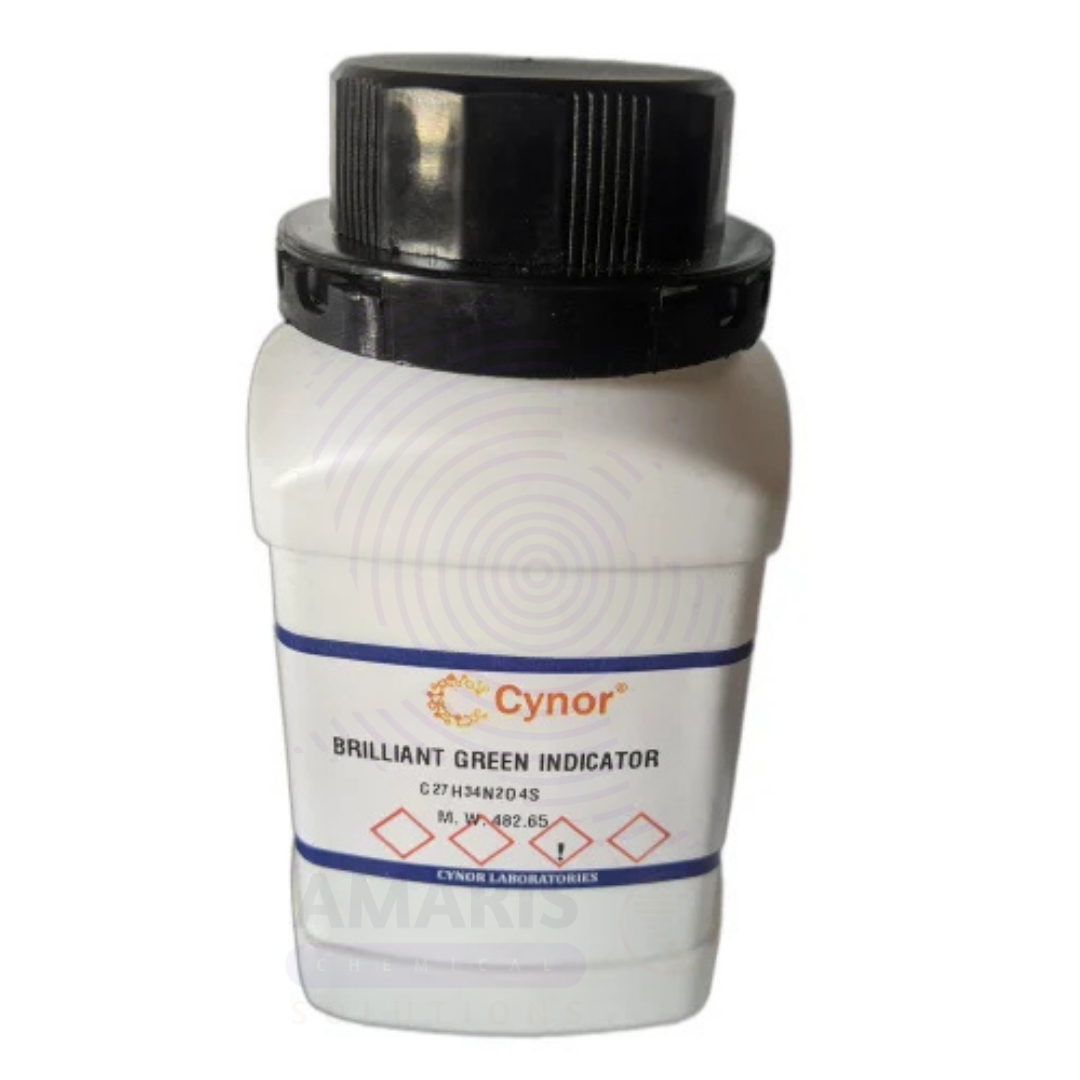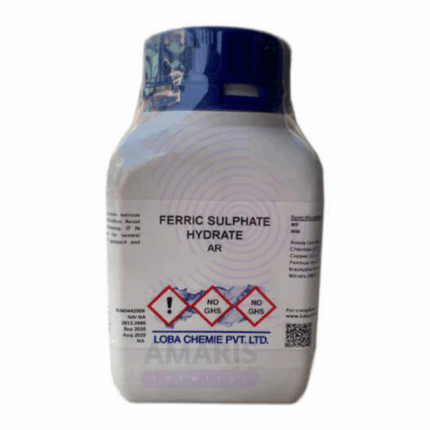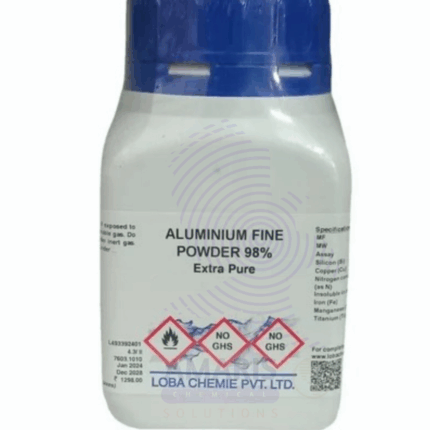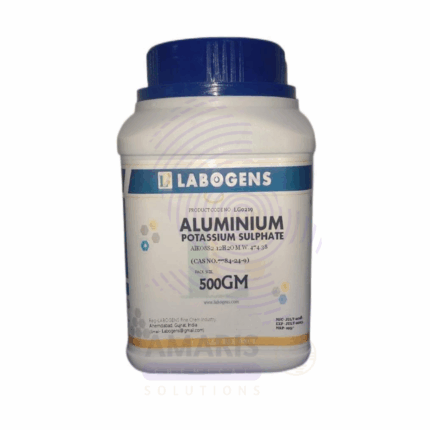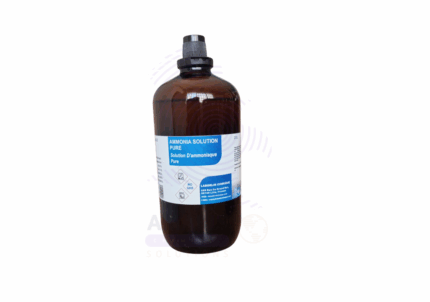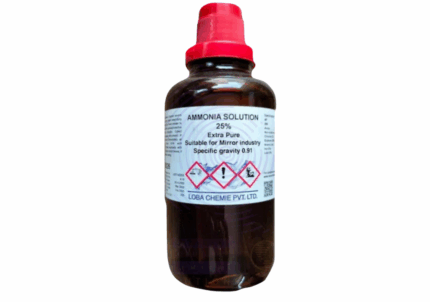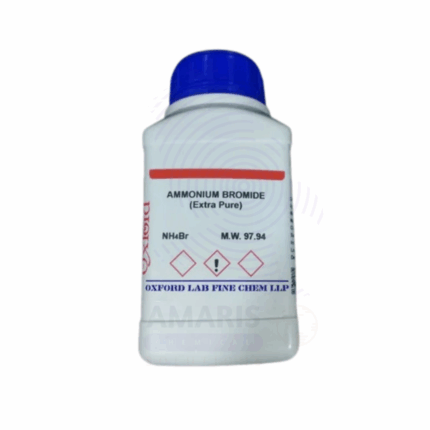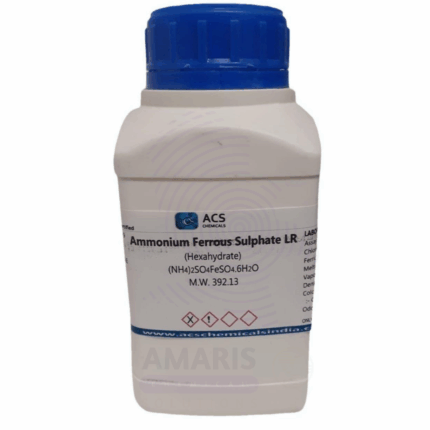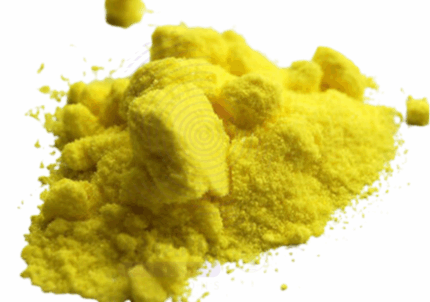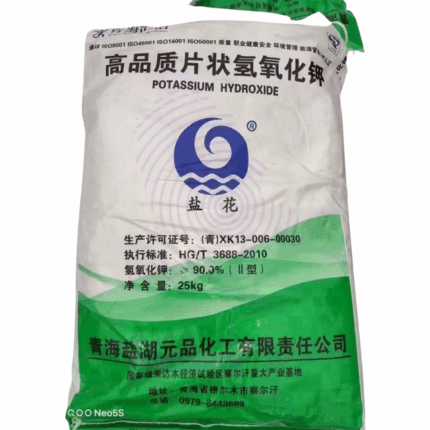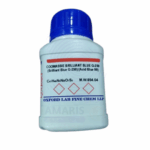
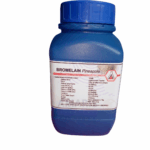
Brilliant Green Extra Pure
$ 17.00 Original price was: $ 17.00.$ 16.67Current price is: $ 16.67.
Brilliant Green Extra Pure is a high-purity, intense green dye primarily used in microbiology and analytical laboratories for staining and selective microbial inhibition. It is especially effective in culture media to isolate specific bacterial strains, such as Salmonella spp., by suppressing the growth of gram-positive organisms. In addition to its antimicrobial role, it serves as a histological stain in biological research and is used in tracing, titration, and other colorimetric assays. The extra pure grade guarantees high dye content, minimal impurities, and excellent consistency, ensuring reliable results in sensitive and precise laboratory work. It should be stored in a tightly sealed container, away from direct light and heat, to preserve its stability and effectiveness.
Brilliant Green Extra Pure
Primary Uses
- Microbiological Selective Agent
- Used as a selective dye in culture media like Brilliant Green Agar to inhibit gram-positive bacteria while promoting gram-negative bacterial growth, particularly Salmonella species.
- Biological Stain
- Employed as a cytoplasmic stain or counterstain in histology and microbiology, particularly in staining fungi, spores, or cell structures.
- pH Indicator and Dye
- Functions as a colorimetric indicator in some analytical titrations, especially where a distinct green shift is desired upon pH change.
Secondary Uses
- Model Compound in Dye Kinetics Studies
- Used in adsorption, diffusion, and photodegradation experiments, especially in environmental chemistry to simulate dye pollution.
- Demonstration of Spectroscopic Behavior
- Utilized in UV-Vis absorbance experiments due to its strong chromophore, helping students understand molar absorptivity and dye spectra.
- Toxicity Bioassays
- Sometimes used in bioassays or aquatic toxicology labs to evaluate dye toxicity in model organisms, such as Daphnia or algae.
| PACK SIZE |
25 grams Plastic Tin |
|---|
1. Basic Identification Attributes
- Chemical Name: Brilliant Green
- Other Names: Malachite Green G, Basic Green 1
- CAS Number: 633-03-4
- HS Code: 3204.13.00
- Molecular Formula: C₂₇H₃₄N₂·Cl
- Grade: Extra Pure (laboratory use)
2. Physical & Chemical Properties
- Physical State: Crystalline powder
- Color & Odor: Green; odorless
- Molecular Weight: 385.04 g/mol
- Melting Point: ~210°C (decomposes)
- Solubility in Water: Soluble (forms a bright green solution)
- Solubility in Alcohol: Soluble
- pH of Aqueous Solution: ~4–6
- Light Sensitivity: Decomposes upon prolonged exposure
- Staining Properties: Strong dye; adheres to organic materials and tissues
3. Safety & Hazard Attributes
- GHS Classification:
- Acute Toxicity (Oral, Category 4)
- Eye Irritation (Category 2A)
- GHS Pictograms: ⚠️
- NFPA Ratings:
- Health: 2
- Flammability: 1
- Reactivity: 0
- Exposure Limits: Not established (handle with caution)
- PPE Requirements:
- Lab coat, gloves, safety goggles
- Inhalation/Ingestion Risks:
- Harmful if swallowed or inhaled
- Skin/Eye Contact:
- May cause irritation; avoid direct contact
4. Storage & Handling Attributes
- Storage Conditions:
- Store in a tightly closed container in a cool, dry place
- Protect from light and moisture
- Incompatible Materials:
- Strong oxidizers, acids
- Container Type: Amber glass or HDPE
- Shelf Life: 2–3 years (if properly stored)
- Special Handling Requirements:
- Handle in well-ventilated area; avoid dust formation
5. Regulatory & Compliance Attributes
- Regulatory Status:
- Not approved for food or drug use
- May be regulated in some jurisdictions due to toxicity
- UN Number: Not regulated for transport
- Waste Disposal Method:
- Dispose of as hazardous chemical waste via licensed facility
- Avoid release to drains or environment
6. Environmental & Health Impact
- Ecotoxicity:
- Toxic to aquatic life; persistent in water systems
- Persistence in Environment:
- High; not readily biodegradable
- Carcinogenicity/Mutagenicity:
- Suspected mutagen; long-term exposure risks under study
- Health Concerns:
- Avoid ingestion or chronic exposure; not for clinical use
SAFETY PRECAUTIONS
- Personal Protective Equipment (PPE):
- Wear lab coat, safety goggles, and nitrile gloves.
- Use a dust mask or respirator if working with powder or aerosol.
- Handling:
- Handle in a fume hood or well-ventilated area.
- Avoid skin and eye contact; avoid inhalation of dust or vapors.
- Prevent formation of dust.
- Storage:
- Store in a cool, dry, and well-ventilated area.
- Keep container tightly closed and protected from light.
- Store away from oxidizing agents and acids.
- Incompatibilities:
- Strong oxidizing agents, strong acids, and light (causes degradation).
FIRST AID MEASURES
- Inhalation:
- Move victim to fresh air.
- If breathing is difficult, provide oxygen.
- Seek medical attention if symptoms persist.
- Skin Contact:
- Wash immediately with soap and water.
- Remove contaminated clothing and wash before reuse.
- Seek medical help if irritation develops.
- Eye Contact:
- Rinse cautiously with water for at least 15 minutes.
- Remove contact lenses if present and easy to do.
- Get medical attention immediately.
- Ingestion:
- Rinse mouth with water. Do not induce vomiting.
- Seek immediate medical attention.
- May cause irritation of the digestive tract.
FIRE FIGHTING MEASURES
- Extinguishing Media:
- Use CO₂, dry chemical powder, alcohol-resistant foam, or water spray.
- Hazardous Combustion Products:
- May release carbon oxides, nitrogen oxides, and toxic fumes when burned.
- Protective Equipment for Firefighters:
- Wear self-contained breathing apparatus (SCBA) and full protective suit.


 Preservatives(food)
Preservatives(food) Flavor Enhancers
Flavor Enhancers Acidulants
Acidulants Sweeteners
Sweeteners Antioxidants
Antioxidants Colorants(food)
Colorants(food) Nutraceutical Ingredients (food)
Nutraceutical Ingredients (food) Nutrient Supplements
Nutrient Supplements Emulsifiers
Emulsifiers
 Collectors
Collectors Dust Suppressants
Dust Suppressants Explosives and Blasting Agents
Explosives and Blasting Agents Flocculants and Coagulants
Flocculants and Coagulants Frothers
Frothers Leaching Agents
Leaching Agents pH Modifiers
pH Modifiers Precious Metal Extraction Agents
Precious Metal Extraction Agents
 Antioxidants(plastic)
Antioxidants(plastic) Colorants (Pigments, Dyes)
Colorants (Pigments, Dyes) Fillers and Reinforcements
Fillers and Reinforcements Flame Retardants
Flame Retardants Monomers
Monomers Plasticizers
Plasticizers Polymerization Initiators
Polymerization Initiators Stabilizers (UV, Heat)
Stabilizers (UV, Heat)
 Antifoaming Agents
Antifoaming Agents Chelating Agents
Chelating Agents Coagulants and Flocculants
Coagulants and Flocculants Corrosion Inhibitors
Corrosion Inhibitors Disinfectants and Biocides
Disinfectants and Biocides Oxidizing Agents
Oxidizing Agents pH Adjusters
pH Adjusters Scale Inhibitors( water)
Scale Inhibitors( water)
 Antioxidants(cosmetic)
Antioxidants(cosmetic) Emollients
Emollients Fragrances and Essential Oils
Fragrances and Essential Oils Humectants
Humectants Preservatives
Preservatives Surfactants(cosmetic)
Surfactants(cosmetic) Thickeners
Thickeners UV Filters
UV Filters
 Fertilizers
Fertilizers Soil Conditioners
Soil Conditioners Plant Growth Regulators
Plant Growth Regulators Animal Feed Additives
Animal Feed Additives Biostimulants
Biostimulants Pesticides (Herbicides, Insecticides, Fungicides)
Pesticides (Herbicides, Insecticides, Fungicides)
 Active Pharmaceutical Ingredients (APIs)
Active Pharmaceutical Ingredients (APIs) Excipients
Excipients Solvents(pharmaceutical)
Solvents(pharmaceutical) Antibiotics
Antibiotics Antiseptics and Disinfectants
Antiseptics and Disinfectants Vaccine Adjuvants
Vaccine Adjuvants Nutraceutical Ingredients (pharmaceutical)
Nutraceutical Ingredients (pharmaceutical) Analgesics & Antipyretics
Analgesics & Antipyretics
 Analytical Reagents
Analytical Reagents Solvents(lab)
Solvents(lab) Chromatography Chemicals
Chromatography Chemicals Spectroscopy Reagents
Spectroscopy Reagents microbiology-and-cell-culture-reagents
microbiology-and-cell-culture-reagents Molecular Biology Reagents
Molecular Biology Reagents Biochemical Reagents
Biochemical Reagents Inorganic and Organic Standards
Inorganic and Organic Standards Laboratory Safety Chemicals
Laboratory Safety Chemicals Specialty Laboratory Chemicals(Special Laboratory Equipment)
Specialty Laboratory Chemicals(Special Laboratory Equipment)
 Demulsifiers
Demulsifiers Hydraulic Fracturing Fluids
Hydraulic Fracturing Fluids Scale Inhibitors(oil)
Scale Inhibitors(oil) Surfactants(oil)
Surfactants(oil) Drilling Fluids
Drilling Fluids
 Dyes and Pigments
Dyes and Pigments Bleaching Agents
Bleaching Agents Softening Agents
Softening Agents Finishing Agents
Finishing Agents Antistatic Agents
Antistatic Agents
 Admixtures
Admixtures Waterproofing Agents
Waterproofing Agents Sealants and Adhesives
Sealants and Adhesives Curing Compounds
Curing Compounds Concrete Repair Chemicals
Concrete Repair Chemicals Anti-Corrosion Coatings
Anti-Corrosion Coatings
 Surfactants(cleaning)
Surfactants(cleaning) Builders
Builders Enzymes
Enzymes Solvents (Cleaning)
Solvents (Cleaning) Fragrances
Fragrances
 Electronic Chemicals
Electronic Chemicals Catalysts
Catalysts Lubricants
Lubricants Photographic Chemicals
Photographic Chemicals Refrigerants
Refrigerants Automotive chemicals
Automotive chemicals Pyrotechnic Chemicals
Pyrotechnic Chemicals
 Biodegradable Surfactants
Biodegradable Surfactants Bio-based Solvents
Bio-based Solvents Renewable Polymers
Renewable Polymers Carbon Capture Chemicals
Carbon Capture Chemicals Wastewater Treatment Chemicals
Wastewater Treatment Chemicals
 Pigments
Pigments Solvents(paint)
Solvents(paint) Specialty Coatings
Specialty Coatings Binders/Resins
Binders/Resins Additives
Additives Driers
Driers Anti-Corrosion Agents
Anti-Corrosion Agents Functional Coatings
Functional Coatings Application-Specific Coatings
Application-Specific Coatings
 Fresh Herbs
Fresh Herbs Ground Spices
Ground Spices Whole Spices
Whole Spices Spice Blends
Spice Blends Dried Herbs
Dried Herbs
 Leavening Agents
Leavening Agents Dough Conditioners
Dough Conditioners Flour Treatments
Flour Treatments Fat Replacers
Fat Replacers Decoratives
Decoratives Preservatives(baking)
Preservatives(baking)
 Plasticizers & Softeners
Plasticizers & Softeners Reinforcing Agents
Reinforcing Agents Adhesion Promoters
Adhesion Promoters Vulcanizing Agents
Vulcanizing Agents Antidegradants
Antidegradants Blowing Agents
Blowing Agents Fillers & Extenders
Fillers & Extenders Accelerators & Retarders
Accelerators & Retarders